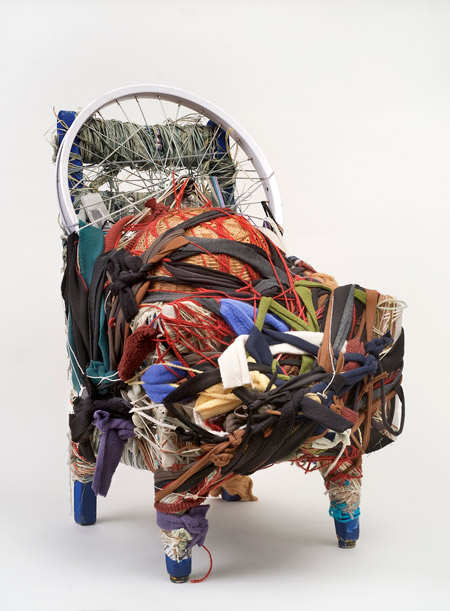
Judith Scott, Untitled, 2004. Courtesy of Creative Growth Art Center, Oakland
Create, an exhibition that highlights the extraordinary contributions of three of the leading centers for artists with disabilities in the United States: San Francisco’s Creativity Explored, Oakland’s Creative Growth Art Center, and Richmond’s National Institute of Art and Disabilities (NIAD Art Center). Curated by BAM/PFA Director Lawrence Rinder, with Matthew Higgs, director of White Columns, New York, the exhibition features over 135 works by twenty artists who have created artworks at these centers over the past twenty-five years. On view from May 11 through September 25, 2011, the exhibition features works by noted artists Judith Scott, William Scott, Willie Harris, James Miles, John Patrick McKenzie, Evelyn Reyes, Aurie Ramirez, and Dan Miller, among others.
“The artists featured in this exhibition—all of whom have some form of developmental disability—possess the talent, independence, and depth of feeling that makes the most powerful art possible,” says BAM/PFA Director Lawrence Rinder.
While the centers are independent of one another and have rarely collaborated, Creativity Explored, Creative Growth, and the NIAD Art Center have a shared history: all three were founded by two pioneers of the art and disabilities movement, Florence Ludins-Katz, an artist and educator, and Elias Katz, a psychiatrist. In the 1970s the Katzes developed an innovative new methodology for supporting artists with developmental disabilities. Their approach focused on a group studio environment, professionalism, and engagement with the broader art community. The San Francisco Bay Area, with its traditionally progressive attitudes towards the rights of disabled peoples, proved the perfect community for advancing these methods. Today artists at these three centers work daily alongside one another, create new works specifically for exhibition and sale, make frequent visits to local galleries and museums, and have regular access to artist mentors who assist them in developing new approaches and techniques.
There is no greater testimony to the success of the Katzes’ process than the extraordinary quality of art consistently being created at these centers. Clichés about how art by the disabled looks are quickly dispelled when confronted with the tremendous diversity of styles and approaches being deployed in Create. Willie Harris creates innovative abstract works in which thickly layered monochrome canvases are attached to one another to form a hybrid of painting and sculpture. Mary Belknap uses a variety of media—Sharpies, watercolors, pencils, and oils—combined with delicate repetition to create brightly colored patterns that seem to dance and move across, and beyond, the paper. Judith Scott created densely compacted sculptures from wool, rubber bands, and other media, evoking the shapes of rocks and chairs. In contrast, Carl Hendrickson’s large but spare wood constructions possess a fragile transparency while alluding to everyday objects such as tables, chairs, and flagpoles. Lance Rivers draws and paints from memory uncannily precise representations of Bay Area train stations, bridges, and other local landmarks. Meanwhile, William Scott’s ebullient portraits combine with inspirational text to evoke a brightly optimistic, utopian vision of San Francisco.
Complete details here.

 RSS
RSS
